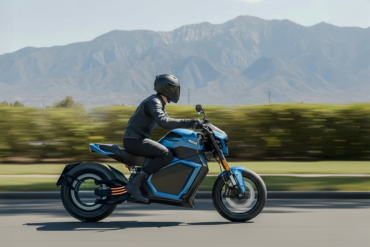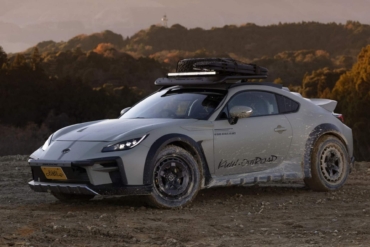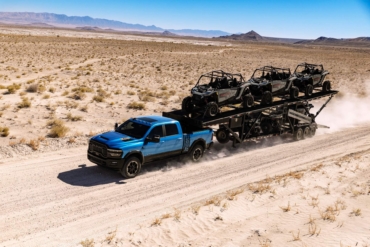Spend enough time driving in winter and you will get stuck. We won’t help you push, but we will give you ways to get your ride back on track.
If you’ve driven in winter conditions for long enough, you’ve gotten stuck in the snow or ice. If you haven’t yet, it’s waiting for you, lurking down a slippery road. I even got myself buried to the axles while working on this story.
So what do you do when you’re stuck in ice or snow? Don’t panic, you can get out of it. We’re here to help with some things you can do and to let you know which things aren’t worth the trouble.

Getting stuck in the snow can start with a slide, by driving into snow that’s too deep, by driving off of the road, or even by parking your vehicle in a driveway. Yes, really, one of the things you learn in a Canadian winter is that you can park on a flat driveway with a light dusting of snow and come back to a car that’s on a patch of ice and won’t budge.
In nearly 25 years of winter driving, I’ve learned the hard — and cold — way what works and what doesn’t when it comes to getting you unstuck in the snow. Here we go.
What to Do When You Get Stuck in the Snow
All of these tips can help you when you’re stuck in ice and snow. That doesn’t mean you need to try all of them or try them in a particular order. But combining a few of them together really ups your chances.
First, Take a Break
When you get stuck in the snow, the first thing you need to do is stop. You’re already stuck, and you don’t want to make it worse. Stop your vehicle, take your foot off of the gas, and relax.
Assess the situation. Sure, mashing the skinny pedal and listening to the tires spin is cathartic, but it’s not going to get you out of the snowbank.
Engage 4WD

I know this will sound obvious, but don’t forget to engage your 4×4 system, if you have it. If you have a modern pickup, you probably already know you need to turn a dial or throw a lever to engage four-wheel drive. On older 4x4s, you might also need to get out and lock the hubs before shifting into 4WD.
Some AWD crossovers have a button to engage the AWD system as well. On a crossover, this button is usually near your gearshift, but a quick look at your owner’s manual will tell you where the switch is and how to make sure it’s turned on.
If you can send power to more tires, you’re much more likely to gain traction and get out of your stuck situation.
Snow Mode to the Rescue

Many modern cars and trucks are loaded with different drive modes. Sometimes those are sports modes that make your vehicle stay at higher rpm all of the time so it feels sportier, but many vehicles also have snow and ice modes. They all work slightly differently, but the main function is that they soften throttle response and relax traction control.
Softening the throttle response lets the car ease onto the power more slowly. Adding power more slowly can let the tires gain traction on snow and ice instead of breaking loose right away. Momentum is both your friend and enemy on low-friction surfaces.
A bit of extra throttle and brake finesse can get you moving in some situations. A snow-driving mode will just make it easier for you to find that finesse.
Keep It Moving

Once the vehicle starts to move, some wheel spin isn’t a bad thing, but a lot is. Momentum is also important when you’re in heavy snow, and aggressive traction control can stop you in your tracks by cutting all of the engine’s power. Winter modes let the tires spin, within limits, keeping you moving forward and letting the tires find traction where they can.
If you don’t have a winter or snow mode, turn your traction control off. There’s usually a button either near the console gear shift or on the left-hand side of the dash (near the headlight switch). If you can’t find yours, check the manual.
Then be very gentle on the throttle (use eco-mode if you have one) until you get moving. Don’t let the wheels spin wildly, keep the speedometer below 35 mph unless you’re at a speed that’s close to 35.
Break Out the Shovel

I know, I know, nobody wants to shovel. I get it. But if you’ve buried the bumper of your car or truck in a snowbank, there’s not a tire in the world with enough traction to get you out of it.
If your drive wheels have dropped down in the snow and your car is resting on its belly pan, you’re going to need to move some of that snow in order to get moving again under your own power.
If you were really moving just before you got stuck, then the underbody of your vehicle might be sitting on a layer of packed snow, keeping your tires off of the ground. In that case, you’ll need to shovel the snow out from under your vehicle, otherwise, it doesn’t matter how much you clear your tires.
Warning: Don’t put your body under the vehicle! When you dig out the snow, the vehicle is going to come down and can crush you under it.
The best way to shovel is (you guessed it) with a shovel, so keeping one in the trunk in the winter is a good idea. If you don’t have one and don’t have good gloves or mittens, try an object that’s in your car.
Removable cup holder inserts work in a pinch, small and square rear floor mats can help, anything that will help you move more than a cold handful of snow at a time. To break up heavy snow, the wrench for the spare tire is quite handy.
True Grit: Sand, Not Salt
If you’re stuck in a big pile of snow, sand isn’t going to cut it to help you get out. If you’re on hard-packed snow or ice, though, it can give you a fighting chance. Common sand used in playgrounds works and is often sold as “traction sand,” which has some fine gravel mixed in to help add more grip.
Don’t bother with salt. It melts ice, but you’re probably not stuck on a large patch of ice. Even wet ice usually gives you enough traction to get moving. Salt itself can add some traction because it comes as large crystals, but spreading some salt won’t really help when you’re stuck in ice or snow.

Leave the Litter at Home
You’ve probably heard kitty litter recommended to help get you out, and if you’ve gone through the rest of our list, are still stuck, are desperate, and it’s the only thing you have, then yeah, sure, give it a try. Enough of it might help you.
The problem with kitty litter is that it’s made of clay. Non-clumping litter is made from granulated clay, while clumping is bentonite clay, so it clumps when it gets wet. Dried clay litter feels coarse, like gravel. Wet clay, which is what litter becomes the moment you put it on snow or ice, is extremely slippery.
So if you have to use it, get nonclumping (it’s slightly less slick), but use large amounts and work fast to try and move, before you get stuck in the mud while stuck in the snow.
Traction Boards, Not Floor Mats
It’s a recommendation as old as cat litter. Throw a floor mat under the tire and that will get you moving. This might work if you’ve got a set of heavy and thick rubber mats with nubs covering the bottom and grooves on the top.
A modern factory floor mat is about as thick as a piece of cardboard and offers about the same amount of traction. Put it under your tire and watch the car launch it out the back. If you’re unlucky, the floor mat will just wedge up into your wheel well and you’ll have to dig it out or risk damaging your ride and starting a fire.

Traction devices like Maxtrax are very useful when stuck in snow, ice, mud, sand, and more. These days, you can even get smaller traction boards, like Maxtrax Minis, which are lightweight and small enough to throw in the back of just about any car. They also work well as a makeshift shovel.
Rocking the Car
Rocking the vehicle means putting it into drive, moving forward slightly, then putting it into reverse and trying to move slightly the other way. The idea is you build up enough momentum to move past the slippery spot.
Rocking does work, but it’s also an easy way to destroy your transmission. Remember that if your tires were spinning, they might not have stopped turning when you switched from drive to reverse. It’s a great way to break expensive parts inside. Like sitting and spinning your tires, it’s also a great way to overheat the transmission.
What you should try instead is to drive the vehicle forward as much as possible, then brake until the wheels stop, put it in reverse, and repeat. Do it slowly and you’ll have a better chance of getting out without breaking down.

Limited Slip Differentials and/or Left Foot Braking
A limited-slip differential is great for helping you not get stuck in the first place. Most cars and trucks have an open differential, helpful for getting around corners, hopeless in the snow.
With an open differential, the wheel with no traction gets all of the torque from the engine. Some front-drive sports cars have a limited-slip differential, which helps make sure both tires get some torque, as do plenty of pickups.
You can help give your vehicle a limited-slip effect with careful use of the brake pedal with the left foot while applying light throttle pressure with the right. Applying the brakes slightly can help stop the wheel with no traction from spinning freely and send some power to the other side.
Saab used to offer a parking brake that worked only on the front wheels (everyone else brakes the rear) so you could engage that brake slightly and help get unstuck. Unfortunately, it’s not as helpful in deep snow, because you’re still stopping the nondriven wheels from turning.
Find Some Pushers
If you haven’t buried your vehicle too deeply, getting a push from some friends or passersby is usually enough to get you out. One or two solid pushers can get a car or truck moving in some seriously bad conditions. Always make sure you’re in the gear that moves you away from the pushers so you don’t run them over.
If you’re getting pushed out, don’t stop as soon as the car starts to move. Keep moving until you’re on firmer ground, or at least a few car lengths from where you were stuck. Get stuck again 10 feet from the last spot and watch how quickly your pushing pals disappear.
Communication with your pushers is key, especially if your usual driver is outside pushing and someone with less driving experience is behind the wheel. Make sure you tell them you’ll be giving the directions, and that you give clear, concise directions. Go, go, go, go, go, go, go, stop!
Again, remember, you don’t want tons of wheelspin. Use just enough throttle to keep the vehicle moving.
Calling for Reinforcements

If all else fails, it might be time for a tow. The best way to get a tow is to call a tow truck. Roadside assistance might even cover it. If there’s a storm, it’s going to be a long wait, so make sure your exhaust pipe is clear of snow and run the engine sparingly to stay warm.
To make things easier for the tow driver, make sure you have a solid recovery point on the end of the vehicle that will be getting a pull. Most trucks and big SUVs have built-in tow hooks, and most cars and crossovers will have a removable towing eye that screws into the bumper, after removing a small plastic cover. Find this tow eye in your vehicle, usually, it’s with your spare tire, and install it before the tow truck arrives to save time.
If someone who wants to give you a tow with their 4×4 comes along, you might be in luck. But you need to be careful, too, because dragging a vehicle out of a snowbank isn’t as easy as it sounds, and can cause plenty of vehicle damage, to both vehicles.
Getting a Hookup
First, you need to attach your vehicle to theirs. For this, you need the right tow rope or tow strap. Using a cheap strap or rope that’s not rated for a lot more than your vehicle weighs is a great way to end up with a broken strap or a low-quality hook through your window.
You need a long strap, at least twice the length of your vehicle. A recovery rope, designed to stretch, is ideal, and not that expensive to keep in your trunk.
You’re also going to need to find a place to attach the rope. Pick the wrong spot and you’re going to end up unstuck but unable to drive. Suspension arms and subframes are all terrible places to pull from. If you have a tow hook or towing eye in the bumper, use that. If you don’t, check your owner’s manual for the proper tow point on your vehicle.
With a tow strap, have the other vehicle slowly move away from you to take up the slack, and then get behind the wheel of your stuck vehicle. Hand signals are a great way to start and stop the pull.
Use gentle acceleration and whatever you do, remember to stop before you smash into the person towing you. Make sure the other vehicle is starting from a solid surface, or else you’ll both end up stuck.
As the old Land Rover adage states, “As fast as necessary and as slow as possible.” Sticking with this line of thought, for both stuck and recovery vehicles, is the best way to ensure a safe recovery that doesn’t cause damage to the vehicles.
Bring It Home
The best way to not get stuck in the snow is to stay home until the roads are clear — and don’t forget about the winter tires. But that’s no fun; getting out in the fluffy slippery stuff is one of the best parts of winter.
So get out there, drive responsibly, have the right gear with you, and don’t venture off of main roads without at least one other vehicle to tow you out.
When you get stuck, and you will, keeping these tips should help you get out of a snowy jam.






